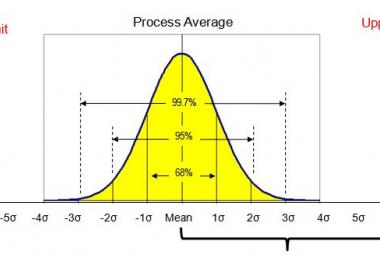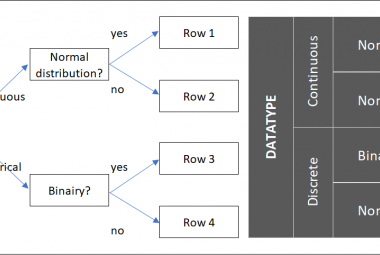Total Productive Maintenance (TPM) is on itself an approach for continuous improvement, which roughly describes the implementation of Preventative- and Autonomous Maintenance. Implementing TPM results in less Muda (waste) and a reduction of Mura (variation) which explains why it can complement a Lean program. In both Lean and TPM, 6S and Standard Work form the foundation of implementation. To elaborate: Autonomous Maintenance consist of seven steps, which include the cleaning of machines, keeping the machines clean, creating standards for machine cleaning and standards for machine inspections (Tajiri & Gotoh; 1992).
BACKGROUND
Illustration 1 shows how TPM and Lean complement one another. The Lean methodologyfocuses on improving the product flow through a value stream (between machines) by reducing the 3 M’s Mura (variation), Muda (waste) and Muri (overburden).
TPM on the other hand, focuses on the machines within a plant. Improving the productivity of each machine – measured by the Overall Equipment Effectiveness (OEE) – is the goal of TPM, by implementing both Preventative- (PM) and Autonomous Maintenance (AM). PM and AM are the tools to prevent the five essential rootcauses of breakdowns (Tajiri & Gotoh, 1992): Neglecting basic machine conditions (1), insuficient operator maintenance skills (2), weakness in equipment design (3), overlooked deterioration (4) and not observing usage conditions (5).
Autonomous Maintenance (AM) can be implemented in seven steps, which can be split inTHREE STAGES OF AM (Tajiri & Gotoh; 1992). These three stages are defined as:standardizing the basic conditions- (1), Maintaining the basic conditions- (2) andsystematically improving the conditions of the machine (3). Illustration 2 visualizes how the three stages of implementation are related to the amount of productivity waste originating in the machine. Standardizing the basic conditions of the machine reduces waste with 20% on average, maintaining that standard by inspections and corrective actions reduces waste with another 70% on average. The final stage deals with the most difficult 10% of waste left in the machine by engineering.
STAGE 1: STANDARDIZING THE BASIC CONDITIONS include the first three steps of implementing Autonomous Maintenance.
Step 1 is cleaning the equipment. This step includes the use of 4 lists on the communication cell, where operators keep track of defective parts (1), a list of questions (2), a list of sources of contamination (3) and a list of hard-to-clean area’s (4). In the latter steps of implementation, these lists can be used for improvement.
Step 2 describes the prevention of contamination of the equipment. Using list 3 and 4 from the previous step, the amount of contamination is reduced – which results in less “stuff” to clean-up – and machines are adjusted to make cleaning easier, which means operators can clean the machine faster.
Step 3 is creating cleaning- and lubrication standards. When critical cleaning area’s are defined (step 1) and improved (step 2), cleaning standards can be created. These standards include a visual representation of the equipment which marks the location of the machine/part, the criteria for “clean”, the method to clean, and the tools to use while cleaning it.
FASE 2: MAINTAINING THE BASIC CONDITIONS is done implementing routine machine inspections (step 4) and creating autonomous maintenance standards (step 5).
In step 4, routine inspections are made by the operators who will perform the inspections in the future. In practice, checklists and process checks don’t work because the lists are created by someone other than the person who needs to use them. Operators are therefore often not committed to use the list. To built the needed commitment, operators should first understand the need of clean machinery and then create their own inspection standards.
Step 5 describes the creation of Autonomous maintenance standards, in which operators perform small maintenance tasks on their machines themselves. These standards should include:
- The category of maintenance, for instance ‘electric’ or ‘moving parts’
- The location of the part on the machine,
- Te criteria the part should meet, like the readableness of measuring instruments.
- The method the check the criteria, and
- The corrective action to be taken when criteria are not met.
STAGE 3: IMPROVING THE STANDARD consists the final two steps of implementation: Quality assurance (step 6) and Autonomous supervision (step 7).
In step 6, the basic conditions are improved on quality aspects. There are five criteria the basic conditions should meet, to guarantee high quality output (Tajiri & Gotoh, 1992). Improvements, or kaizen, should be focused on these five criteria:
- It is clear to every one what the basic conditions of the machine are
- The basic conditions are easy to readjust
- The conditions are not exposed to variability
- Deviations from the standard are visualized
- And easy to bring back to standard
Step 7, finally, describes the autonomous supervision of machines. In this step, equipment is completely maintained by operators. They check the equipment for abnormalities, take action when certain conditions deviate from the standard and improve the basic conditions of the equipment. The challenge in this last step is keeping autonomous maintenance at this level, which means continuous knowledge sharing to prevent the general knowledge level from dropping back, which will lead to back dropping of machine conditions to their original state.
This is an article in de series ‘Lean Toolbox‘,
Continue to:
REFERENCE:
Tajiri, M. & Gotoh, F., 1992, Autonomous Maintenance Implementation, Portland: Productivity Inc. (order this book)












